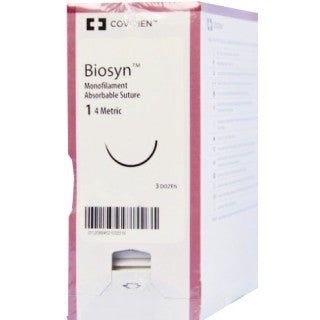Description
Covidien CM925 - SUTURE, BIOSYN, 1 36" VIOLET GS-21, 36/BX

Covidien CM925 BIOSYN Monofilament Absorbable Suture, Taper Point, Size 1, Violet, 36", Needle GS-21, 1/2 Circle (Pack of 36)
Bison synthetic absorbable sutures are prepared from Glomar 631, a synthetic polyester composed of glycoside (60%), diolamine (14%), and trim ethylene carbonate (26%). These sutures are colored violet to increase visibility and are also available undyed. Bison sutures are indicated for use in general soft tissue approximation and/or ligation including use in ophthalmic surgery, but not for use in cardiovascular or neurological surgery.
Taper Point - Biosyn Size 1 Violet 36" GS-21
| Item Number | Structure | Suture Type | Size USP | Metric | Length. (CM) | Color | Box Qty |
| CM925 | Monofilament | Mid-Term Absorbable | 1 | 4 | 90 | Violet | 36 |

Excellent Strength and Security
Biosyn monofilament absorbable sutures have the tensile strength needed for the critical wound healing period of about three weeks. Biosyn synthetic sutures are prepared from Gylcomer 631, a synthetic polyester composed of glycolide (60%), dioxanone (14%), and trimethylene carbonate (26%). These sutures are colored violet to increase visibility and are also available undyed. Biosyn sutures are indicated for use in general soft tissue approximation, subcuticular skin closure and/or ligation including use in ophthalmic surgery.
The advanced extrusion process of the molecule of Gylcomer 631 gives the suture:
- Excellent initial strength
- Excellent in-vivo strength over the critical wound healing period
- Excellent knot security
- Minimal memory for handling ease
Biosyn sutures are indicated for use in general soft tissue approximation and/or ligation including use in ophthalmic surgery, but not for use in cardiovascular or neurological surgery.
Biosyn Monofilament Synthetic Absorbable Sutures Less Prone to Bacterial Colonisation than Vicryl Plus Antibacterial Suture
While sutures are rarely associated with infection, the reduced surface area of a monofilament suture and its lack of interstitial spaces further minimise the risk of infection by reducing the ability of bacteria to harbor where they can multiply. The Centers for Disease Control (CDC) recognise that when a wound contains more than 100,000 Colony Forming Units (CFUs) per gram, there is an increased risk of surgical site infection.

In recent tests performed under the direction of John Thomas, Ph.D., from the University of West Virginia, Biosyn monofilament suture was shown to have statistically less bacterial colonisation than braided sutures, including Vicryl Plus (containing the biocidal agent, triclosan), when exposed to S. aureus bacteria.4 Based on these results, monofilament synthetic sutures such as Biosyn should be considered as an alternative (where a monofilament is appropriate) to braided sutures when infection is a concern.
Indications
Biosyn synthetic absorbable sutures are indicated for use in general soft tissue approximation and/or ligation including use in ophthalmic surgery, but not for use in cardiovascular or neurological surgery.
Contraindications
This suture, being absorbable, should not be used where extended approximation of tissue is required.
Composition
Synthetic polyester composed of glycolide, dioxanone, and trimethylene carbonate.
Actions
Biosyn synthetic absorbable sutures elicit a minimal acute inflammatory reaction in tissues, which is followed by gradual encapsulation of the suture by fibrous connective tissue. Progressive loss of tensile strength and eventual absorption of Biosyn synthetic absorbable sutures occurs by means of hydrolysis where the suture is broken down to glycolic acid, dioxanoic acid, propane diol and carbon dioxide which are subsequently absorbed and metabolized by the body.
Tensile Strength
Studies in animals indicate tensile strength averages for Biosyn synthetic absorbable sutures are approximately 75% of U.S.P and E.P. minimum knot strength at two weeks and approximately 40% at three weeks post-implant.
- 2 weeks: 75% USP
- 3 weeks: 40% USP
Sterilization
- Ethylene oxide.
Abosrbations
Absorption begins as a loss of tensile strength without appreciable loss of mass. Absorption of Biosyn synthetic absorbable sutures is essentially complete between 90 and 110 days.
Packaging
Biosyn synthetic absorbable sutures are available undyed (natural) or dyed violet in U.S.P. and E.P. sizes 1 (4 Metric) through 60 (0.7 Metric). The sutures are supplied sterile, in pre-cut lengths or affixed to various needle types using both permanent and removal needle attachment techniques. Please refer to the individual package IFUs for complete instructions, indications, contraindications, warnings and precautions.
Device Characteristics
| What MRI safety information does the labeling contain? | Labeling does not contain MRI Safety Information |
| Device required to be labeled as containing natural rubber latex or dry natural rubber (21 CFR 801.437): | No |
| Device labeled as "Not made with natural rubber latex": | No |
| For Single-Use: | Yes |
| Prescription Use (Rx): | Yes |
| Over the Counter (OTC): | No |
| Kit: | No |
| Combination Product: | No |
| Human Cell, Tissue or Cellular or Tissue-Based Product (HCT/P): | No |
Frequently asked questions
Q: Biosyn suture "spits" more than Monocryl?
A: Monocryl* is fully absorbed in 91 - 119 days, whereas Biosyn suture is fully absorbed in 90 - 110 days.
Q: Biosyn suture breaks when repositioned?
A: With Biosyn suture, theres no need to reposition the throw. Just run down the knot and the step is finished.
Q: What is the corresponding suture in the Ethicon portfolio?
A: Monocryl
